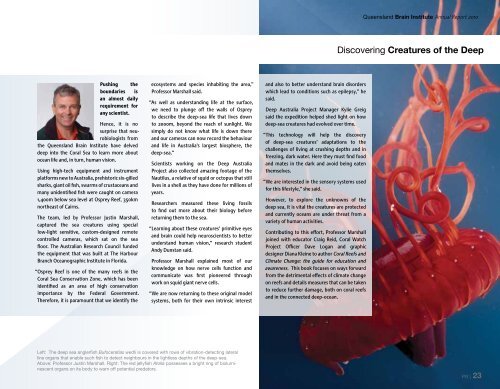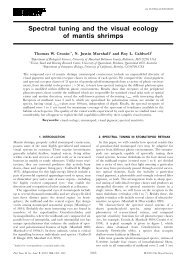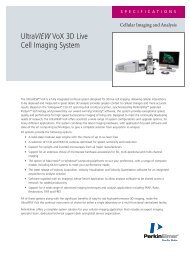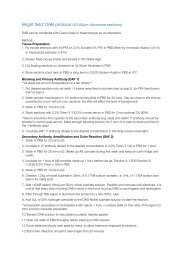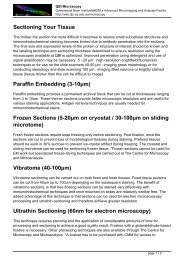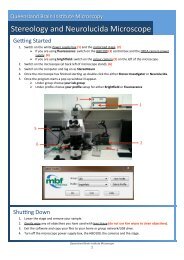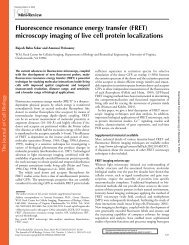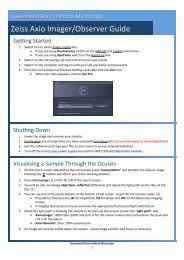Queensland Brain Institute 2010 Annual Report - University of ...
Queensland Brain Institute 2010 Annual Report - University of ...
Queensland Brain Institute 2010 Annual Report - University of ...
You also want an ePaper? Increase the reach of your titles
YUMPU automatically turns print PDFs into web optimized ePapers that Google loves.
<strong>Queensland</strong> <strong>Brain</strong> <strong>Institute</strong> <strong>Annual</strong> <strong>Report</strong> <strong>2010</strong>Discovering Creatures <strong>of</strong> the DeepPushing theboundaries isan almost dailyrequirement forany scientist.Hence, it is nosurprise that neurobiologistsfromthe <strong>Queensland</strong> <strong>Brain</strong> <strong>Institute</strong> have delveddeep into the Coral Sea to learn more aboutocean life and, in turn, human vision.Using high-tech equipment and instrumentplatforms new to Australia, prehistoric six-gilledsharks, giant oil fish, swarms <strong>of</strong> crustaceans andmany unidentified fish were caught on camera1,400m below sea level at Osprey Reef, 350kmnortheast <strong>of</strong> Cairns.The team, led by Pr<strong>of</strong>essor Justin Marshall,captured the sea creatures using speciallow-light sensitive, custom-designed remotecontrolled cameras, which sat on the seafloor. The Australian Research Council fundedthe equipment that was built at The HarbourBranch Oceanographic <strong>Institute</strong> in Florida.“Osprey Reef is one <strong>of</strong> the many reefs in theCoral Sea Conservation Zone, which has beenidentified as an area <strong>of</strong> high conservationimportance by the Federal Government.Therefore, it is paramount that we identify theecosystems and species inhabiting the area,”Pr<strong>of</strong>essor Marshall said.“As well as understanding life at the surface,we need to plunge <strong>of</strong>f the walls <strong>of</strong> Ospreyto describe the deep-sea life that lives downto 2000m, beyond the reach <strong>of</strong> sunlight. Wesimply do not know what life is down thereand our cameras can now record the behaviourand life in Australia’s largest biosphere, thedeep-sea.”Scientists working on the Deep AustraliaProject also collected amazing footage <strong>of</strong> theNautilus, a relative <strong>of</strong> squid or octopus that stilllives in a shell as they have done for millions <strong>of</strong>years.Researchers measured these living fossilsto find out more about their biology beforereturning them to the sea.“Learning about these creatures’ primitive eyesand brain could help neuroscientists to betterunderstand human vision,” research studentAndy Dunstan said.Pr<strong>of</strong>essor Marshall explained most <strong>of</strong> ourknowledge on how nerve cells function andcommunicate was first pioneered throughwork on squid giant nerve cells.“We are now returning to these original modelsystems, both for their own intrinsic interestand also to better understand brain disorderswhich lead to conditions such as epilepsy,” hesaid.Deep Australia Project Manager Kylie Greigsaid the expedition helped shed light on howdeep-sea creatures had evolved over time.“This technology will help the discovery<strong>of</strong> deep-sea creatures’ adaptations to thechallenges <strong>of</strong> living at crushing depths and infreezing, dark water. Here they must find foodand mates in the dark and avoid being eatenthemselves.“We are interested in the sensory systems usedfor this lifestyle,” she said.However, to explore the unknowns <strong>of</strong> thedeep sea, it is vital the creatures are protectedand currently oceans are under threat from avariety <strong>of</strong> human activities.Contributing to this effort, Pr<strong>of</strong>essor Marshalljoined with educator Craig Reid, Coral WatchProject Officer Dave Logan and graphicdesigner Diana Kleine to author Coral Reefs andClimate Change: the guide for education andawareness. This book focuses on ways forwardfrom the detrimental effects <strong>of</strong> climate changeon reefs and details measures that can be takento reduce further damage, both on coral reefsand in the connected deep-ocean.Left: The deep sea anglerfish Bufoceratias wedli is covered with rows <strong>of</strong> vibration-detecting lateralline organs that enable such fish to detect neighbours in the lightless depths <strong>of</strong> the deep-sea.Above: Pr<strong>of</strong>essor Justin Marshall. Right: The red jellyfish Atolla possesses a bright ring <strong>of</strong> bioluminescentorgans on its body to warn <strong>of</strong>f potential predators.PG | 23


